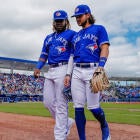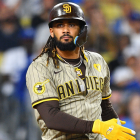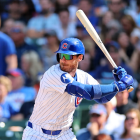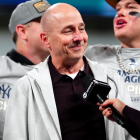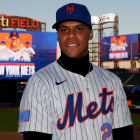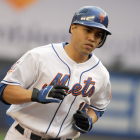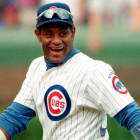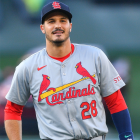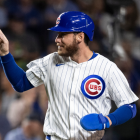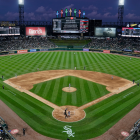
Should the novel coronavirus permit, Major League Baseball will kick off its regular season on July 23. The season will be an abbreviated one, lasting just 60 games and featuring a slew of modifications, including a universal DH and altered extra-inning rules. Even the rosters will be different, with teams carrying 30 players to begin the year before gradually getting down to 26.
Because you can't have a baseball season (however weird) without team previews, we'll be touching on every team between now and Opening Day.
Today, that means highlighting the Toronto Blue Jays.
The Blue Jays are seeking their first playoff appearance since 2016, when they lost in the American League Championship Series. They'd probably settle for avoiding fourth place in the division for a fourth year in a row. Whether or not that's doable hinges largely on two factors: their young hitters and their older pitchers. Simple enough, huh?
Even if realistic contention still seems a year away, the Blue Jays have a chance to be respectable. At times, they might even qualify as one of the most exciting teams in the league.
Win total projection, odds
2020 Sportsline projection: 28-32
World Series odds (via William Hill Sportsbook): 75/1
2019 record: 67-95
Projected lineup
- SS Bo Bichette
- 2B Cavan Biggio
- 3B Vladimir Guerrero Jr.
- 1B Travis Shaw
- LF Lourdes Gurriel Jr.
- CF Randal Grichuk
- RF Teoscar Hernandez
- DH Derek Fisher
- C Danny Jansen
Bench: C Reese McGuire; 2B Joe Panik; OF Anthony Alford; 1B Rowdy Tellez
The Blue Jays mostly return the same lineup from the end of last season. The exceptions are Travis Shaw, who is hoping to bounce back after a horrid season in Milwaukee, and Joe Panik. The keys to the lineup are the youngsters: Bichette, Biggio, Gurriel, and, obviously, Guerrero. The Blue Jays don't have a ton of position-player depth, so they'll need to stay healthy.
Projected rotation
- LHP Hyun-Jin Ryu
- RHP Tanner Roark
- RHP Chase Anderson
- RHP Matt Shoemaker
- RHP Trent Thornton
The Blue Jays were aggressive in overhauling their rotation over the winter. That led them to signing Ryu and Roark and trading for Anderson. There's a fair amount of risk in this group, as we'll address below, but they do have some depth if and when the need arises in the form of Ryan Borucki, Anthony Kay, Sean Reid-Foley, and, of course, Nate Pearson.
Projected bullpen
- Closer: RHP Ken Giles
- Setup: RHP Anthony Bass, RHP Shun Yamaguchi
- Middle: RHP Sam Gaviglio; RHP Rafael Dolis
- Long: RHP Wilmer Font
It's possible the Blue Jays have to use a few of those names in the bullpen if they're serious about making a run. The extent of their offseason tweaking entailed claiming Anthony Bass off waivers and signing Shun Yamaguchi, Rafael Dolis, and Marc Rzepczynski. Toronto will have to milk more from this unit than its lacking name-brand value suggests is possible.
Is there enough pitching?
As noted above, the Jays overhauled their rotation over the offseason. They didn't do as much for their bullpen, and the result is a pitching staff with an uneven amount of risk given the moderate reward.
The rotation's chances of being decent rest on Ryu and Pearson. Ryu, a left-handed changeup artist, has posted a 2.21 ERA and a 6.46 strikeout-to-walk ratio over the past two seasons. The catch with him is that he's not known for his durability. Last season's 182 innings represented the first time he had surpassed 150 in a season since 2014. Pearson, for his part, has a huge arm and a legit chance at becoming Toronto's next homegrown ace. Still, it's worth noting that he has just 123 professional innings under his belt since being drafted in 2017. The Blue Jays could decide to manipulate his service time, too, which would limit his potential impact.
Beyond Ryu and eventually Pearson, the Blue Jays are banking on a slew of mid-to-back-end types. Anderson has always been home-run-prone; Roark is solid if not flashy; Shoemaker hasn't thrown 100 innings in a season since 2016; and Thornton might well end up in the bullpen. If there's good news for Toronto, it's that they have enough excess to think someone will perform at a passable level. Keep Ryan Borucki, Jacob Waguespack, Anthony Kay, and Sean Reid-Foley's names in mind; given the risk elsewhere, they should come in handy.
The bullpen is arguably less certain than the rotation, which is saying something.
There's Ken Giles, who figures to be a walking trade rumor provided he's healthy, and then a bunch of unknowns. Anthony Bass was quietly productive last season behind a sinker-slider-splitter arsenal, and the Mariners rewarded him by designating him for assignment in October. Shun Yamaguchi has ample experience as a starter and a reliever. He's not going to overpower anyone, but the Blue Jays are hopeful his arsenal depth can help him outwit hitters. The Blue Jays also signed Rafael Dolis from Japan. He hasn't pitched in the majors since 2013, but he found enough success in the NPB to be worth the look-see as a middle reliever.
Elsewhere, Toronto could load up on bulk types. Sam Gaviglio threw 95 innings without making a start last season, and both Thomas Pannone and Wilmer Font are capable of multi-inning outings if and when needed.
Maybe the Blue Jays can get an extra something from a few of these names. On paper, though, it isn't the most encouraging group, especially with regards to the bullpen.
What's next for the young hitters?
The strength of this Blue Jays team is their glut of young, promising hitters. For clarity's sake, we're talking about Guerrero, Bichette, Gurriel, and Biggio. All four of them were above-average hitters last season, and it's natural to wonder if they'll get even better heading forward.
We've covered Guerrero in greater detail before, so we'll keep it brief here: he has to learn to lift the ball more in order to maximize his power output.
Bichette probably won't keep up the pace with what he did last season, when he batted .311/.358/.571 with 11 home runs in 46 games. He showed a very aggressive approach, in terms of swinging in and outside of the zone, and he could stand to reel that in and improve upon his strikeout-to-walk ratio. That said, nobody will care about that if he can consistently hit the ball hard enough to post a .300-something average and .500-something slugging percentage.
Gurriel doesn't get nearly as much attention as either Guerrero or Bichette, and it's been a struggle to find a defensive home, but he's solidified himself as an above-average hitter the past two seasons. In 149 career games to date, he's hit for a 118 OPS+ and has homered 31 times. As with Bichette, you'd probably prefer to see him walk a little more often, but he can really hit.
Then there's Biggio, a single-issue player whose single issue is not swinging the bat. He's patient to the point where it threatens on passive, but it worked for him last season. Because of his commitment to working deep counts, and because of a tendency to swing-and-miss, he's always going to strike out a lot. Add in a vertical swing path, which led to one of the highest launch angles in baseball last season, and there's a real risk he strikes out and pops up too often for his on-base and slugging sides to overcome.
You could also throw catcher Danny Jansen into this group. His glove has been ahead of his bat to date, but he has a feel for the zone and hit the ball harder than the league-average last year. It's possible he produces more at the plate heading forward.
When will Pearson arrive?
We'll end with the obvious question facing this Blue Jays team: when will they promote Pearson to the majors? The answer is, almost certainly, one of the following: after they've gained an extra year of control, or after they've ensured he won't qualify for Super Two status.
Given Pearson's limited professional track record, it's more justifiable than their other recent service-time manipulations. But nothing says "baseball is back" like having to weigh whether or not a team is holding down a prospect for good-faith reasons.









